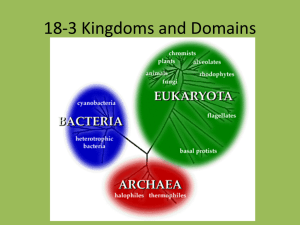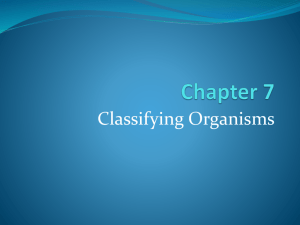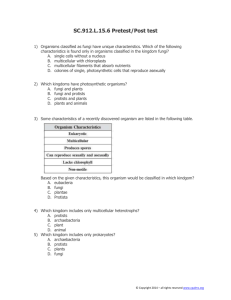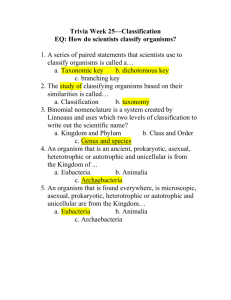Biological Kingdoms
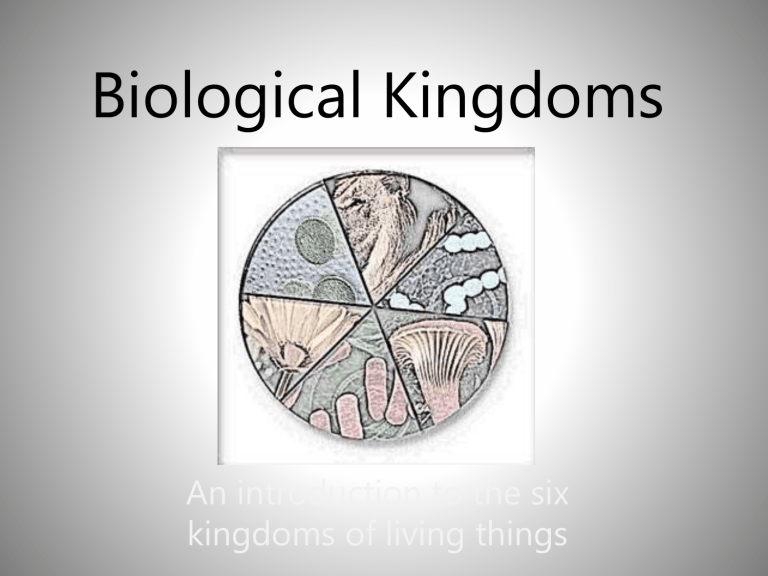
Biological Kingdoms
An introduction to the six kingdoms of living things
3 Domains
Archa ea
6 Kingdoms
Archaebac teria
Bacte ria
Eukarya
Planta e
Anim alia
Eubact eria
Fungi
Protist a
Domain Eukarya
Kingdom
Click video to play
Animals are a group of multicellular eukaryotic organisms
.
The word animal comes from the Latin word animalis meaning “having breath.”
Animals are different from other eukaryotes in a number of ways. First, animal cells lack the rigid cell wall that plants, fungi, and algae have.
Second, animals are heterotrophic, meaning that they must ingest other organisms in order to survive. Heterotrophs are the consumers in the food chain. Third, all animals are motile, or able to move, at least during one stage of their life cycle.
Nearly all animals undergo some form of sexual reproduction, where specialized sex cells form and fuse together to form zygotes, which develop into individuals. Some animals are also capable of asexual reproduction, through budding or forms of cloning.
The Kingdom Animalia is divided into approximately
40 Phyla including Phylum Chordata, which includes all the vertebrate animals, or animals with a backbone and spinal column. Humans, as well as fish, birds, reptiles, amphibians, and other mammals, belong to the Phylum Chordata. Other phyla include Phylum
Arthropoda, to which crabs, spiders, and insects belong; and Phylum Nematoda, which are the roundworms.
Domain Eukarya
Kingdom Plantae
Organisms from the Kingdom Plantae are multicellular eukaryotic organisms. Plants have characteristics that make them different from other eukaryotic organisms. One of the main differences is that they are autotrophic, meaning they are able to make their own food using simple inorganic substances. They do this through a process known as photosynthesis, in which plants convert sunlight, water, and carbon dioxide into sugar and oxygen. Plants are multicellular and, unlike animals, their cells have rigid cell walls made from cellulose or hemicellulose.
Some species of plants reproduce sexually and some reproduce asexually. In asexual reproduction, such as budding, an exact copy of the parent is produced. Plant sexual reproduction can be assisted by animals, as is the case with flowers and honeybees.
As the bees go from flower to flower collecting nectar, they carry pollen, plant sex cells, with them and pollinate other plants.
Pollination is the first step in plant sexual reproduction.
The Kingdom Plantae is divided into 11 Phyla.
Phylum Coniferophyta are cone producing plants. Most of the
Conifers are evergreens like pines and firs.
Phylum Anthophyta are flowering, seed producing plants.
They are a very diverse group and include organisms such as strawberry plants, palm trees, and water lilies.
Phylum Bryophyta are mossessmall, soft plants that don’t have flowers or seeds. They absorb water and nutrients through their leaves.
Plants are a very diverse group!
Domain Eukarya
Kingdom fungi
Click to start video
Fungi are a large group of eukaryotic organisms that includes such organisms as yeasts, molds, and mushrooms. Many fungi are multicellular, but some are unicellular.
Some differences between fungi and other eukaryotes are at the cellular level. Fungal cells have cell walls that contain chitin, unlike plant cell walls which contain cellulose. Another difference between plant cells and fungal cells is that fungal cells lack chloroplasts, so most fungi are heterotrophs. They take in nutrients by absorbing them from their environment.
Fungi reproduction is complex. Many fungi reproduce both asexually and sexually at different stages in their life cycles. Fungal reproduction often involves the production and dispersal of spores.
Fungi can be both harmful and helpful. Some fungi grow in or on plants or animals causing disease, such as Dutch Elm Disease or
Ringworm. Other fungi, such as the mold that the antibiotic penicillin is made from, can help organisms by killing bacteria.
Domain Eukarya
KINGDOM PROTISTA
Click video to start
Protists are a diverse group of eukaryotic microorganisms. They do not have much in common except that they are relatively simple eukaryotes.
They are either unicellular or multicellular without reaching the specialized tissue level of organization. Protists include organisms such as algae, amoebae, protozoans, euglena, and slime molds.
Protists live in almost any environment that contains liquid water.
Some protists, such as algae, are photosynthetic, so they are autotrophs. Other protists are heterotrophs, obtaining nutrients from their environment. Amoebae engulf, or take into their membrane, other cells. This process is called phagocytosis.
Most protists reproduce asexually, through a form of cell division. Other protists engage in a form of sexual reproduction.
Some protists are responsible for diseases such as malaria in humans and potato blight in potato plants. Research scientists are experimenting with ways to use protists to wipe out fire ants and other pests.
Domain Bacteria
Kingdom Eubacteria
Kingdom Eubacteria
Organisms in the Kingdom Eubacteria are unicellular prokaryotes.
Prokaryotes do not have a membrane bound nucleus or membrane bound organelles. Eubacteria are found in all habitats. Some eubacteria remain independent as single cells and others group into colonies.
Eubacteria reproduce asexually through cell division.
Some eubacteria are autotrophic, making their own food, and others are heterotrophic, taking in nutrients from their environment.
Eubacteria can cause various diseases, from strep throat to Rocky
Mountain spotted fever, but they can also be very helpful. Lactobacillus is used to help make foods like cheese and yogurt, and is also present in the human digestive system. Decomposing organic matter and cycling nitrogen are also important functions of eubacteria.
Domain Archaea
Organisms in Kingdom Archaebacteria are unicellular prokaryotes.
They have no membrane bound nucleus or organelles in their single celled bodies. Archaebacteria are similar in size and shape to eubacteria. The differences between the two have more to do with their chemical and genetic make up. Some of the genes of archaebacteria are more closely related to eukaryotes than eubacteria. The cell walls of archaebacteria are different from both eubacteria and eukaryotes.
Like eubacteria, archaebacteria reproduce asexually through cell division. They can also be autotrophic, making their own food, or heterotrophic, obtaining food from their environment, just like eubacteria.
Some archaebacteria are extremeophiles, living in extreme environments such as in hot springs, extremely acidic environments, polar seas, and even in extremely salty water.

